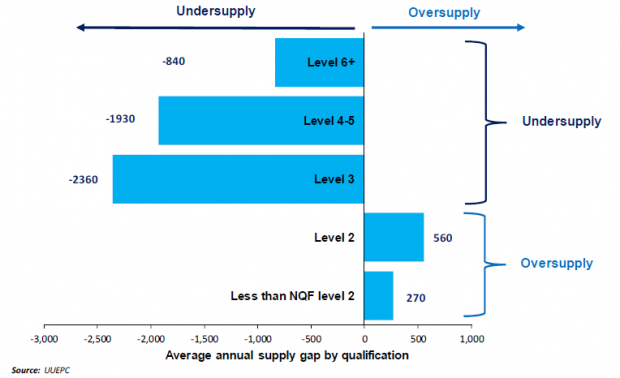2021 update
The 2021 update, published in March this year, projects the skills new workers need up to 2030 based on a high economic growth scenario. It predicts that almost two-fifths (37 per cent) of new workers will require NQF level 6 and above qualifications (ie undergraduate degree, masters, PhD). This figure has increased from 29 per cent of the first iteration of the Skills Barometer (2015-2025), providing clear evidence that employers are becoming more degree hungry. At this level, the largest undersupply for new workers is forecast amongst STEM subjects.
It is predicted that almost 12 per cent of new workers will require NQF Level 4-5 qualifications (ie foundation degrees, higher national diploma/certificate). The most in demand subjects at this level are Health Public Services and Care; Engineering and Manufacturing Technologies; and Business, Administration, Finance and Law. Together these top three subjects account for almost half (48 per cent) of labour demanded at this level.
At the bottom end of the qualification spectrum, the squeeze on lower qualified workers is projected. Only 8 per cent of new worker demand will be at NQF level 2 and below (5 GCSEs A*-C or less). This figure has fallen from 16 per cent in the first iteration of the Skills Barometer (2015-2025), and has coincided with a rapid increase in education attainment amongst education leavers.
It is forecast that the largest undersupply for new workers will be for those with mid-level skills (NQF Level 3-5). This is linked to relatively few qualifiers entering the labour market with these qualifications, rather than an excess demand.
Average annual labour market supply gap by qualification (NQF), NI, 2020-2030
The graph below shows the forecasted average annual labour market supply gap by qualification level:

Note: The supply gaps in the above chart have been calculated based on ‘effective supply’. This takes account of migration patterns amongst qualifiers at NI institutions and NI domiciled qualifiers qualifying from GB institutions, in addition to labour force participation. A supply adjustment is then applied to subtract tertiary qualifiers who require additional skills development to effectively fulfil the requirements of tertiary level employment. This group are not included in the above chart.
Sources and notes
- Information has been taken from the 2021 Skills Barometer update, available here: Northern Ireland Skills Barometer 2021 update
- Subject areas for undersupply forecasts at NQF Level 6+ have been defined to the 1-digit Joint Academic Coding system.
